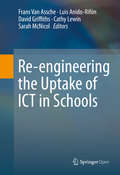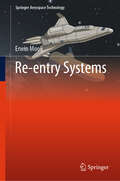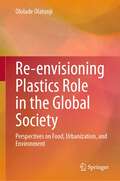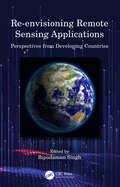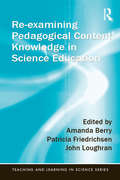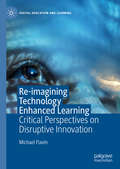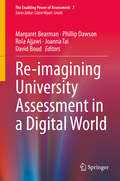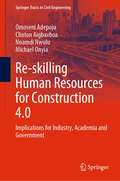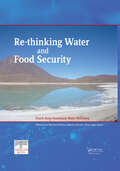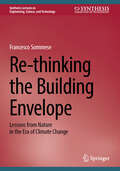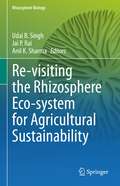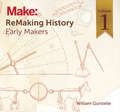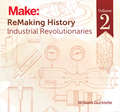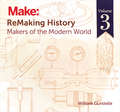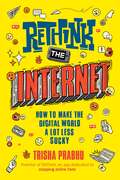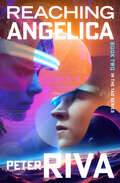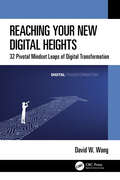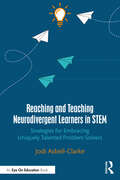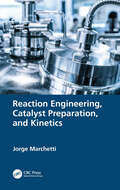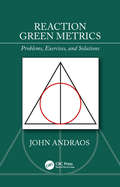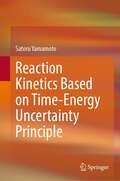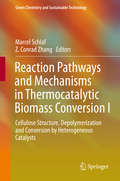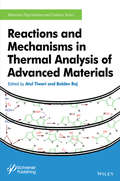- Table View
- List View
Re-engineering the Uptake of ICT in Schools
by David Griffiths Cathy Lewin Frans Van Assche Luis Anido Sarah McnicolThis book reports on a novel and comprehensive approach to the uptake of ICT in Schools. It focuses on key questions, pedagogically sound ways of introducing ICT, new technical artifacts supporting the approach, the evaluation in a large-scale validator, and future work. While many innovations in Technology Enhanced Learning (TEL) have emerged over the last two decades, the uptake of these innovations has not always been very successful, particularly in schools. The transition from proof of concept to integration into learning activities has been recognized as a bottleneck for quite some time. This major problem, which is affecting many TEL stakeholders, is the focus of this book which focuses on developing a more effective and efficient approach based on more than 2500 pilots in European classrooms. Teachers, head teachers, and policy makers may benefit from reading how novel learning scenarios can be elaborated, adapted to a local context, and implemented in the classroom; how new technologies can support this process for teachers and their national/regional communities; how teachers and other stakeholders can be educated in such a re-engineering process; how the approach can be scaled up through MOOCs, ambassador schemes, and train-the-trainer programs; how future classroom labs can inspire teachers, head teachers, and policy makers; how teachers and, above all, learners can become more engaged in learning through the adoption of the iTEC approach. Readers with a more technical focus may also be interested in the discussion of recommender systems, the flexible provision of resources and services, the deployment of the cloud in schools, and systems for composing technological support for lesson plans.
Re-entry Systems (Springer Aerospace Technology)
by Erwin MooijThis book explains and describes re-entry systems for both the Earth and other planets. It provides sufficient information for readers to perform entry mission analysis for different bodies in the Solar System. Not only does it discuss re-entry flight mechanics, but also addresses relevant subsystems and fields, enabling readers to put the information into perspective. The book begins with a complete description of planetary environments, including atmosphere, gravity fields and the shape of the primary body. After a detailed discussion of planar flight mechanics, it then moves on to discuss guidance, navigation, and control, entry, descent, and landing systems, as well as thermal protection systems. It uses examples throughout the text, enabling the theory to be linked to practical applications. Ideal for those wanting an updated, thorough discussion of re-entry systems, this book is suitable for students and researchers.
Re-envisioning Advances in Remote Sensing: Urbanization, Disasters and Planning
by Ripudaman SinghRe-envisioning Advances in Remote Sensing: Urbanization, Disasters and Planning aims at portraying varied advancements in remote sensing applications, particularly in the fields of urbanization, disaster management and regional planning perspectives. The book is organized into three sections of overlapping areas of research covering chief remote sensing applications. Apart from introducing the advances in remote sensing through Indian remote sensing developments, it depicts the broader themes of: urbanization and its impacts; geospatial technology for disaster management; and, remote sensing applications in models and planning. It also provides outlook to future research agenda for remote sensing. Features: • Depicts advances in remote sensing in major fields through applications of geospatial technologies.• Covers remote sensing applications in varied aspects of urbanization, urban problems and disasters. • Includes advancements in remote sensing in model building and planning perspectives.• Analyses the usage of smartphones and other digital devices in mapping urban problems and monitoring disaster risks.• Explores future agenda for remote sensing advances and its ever-widening horizon. This book would be of interest to all the researchers and graduate students pursuing studies in the fields of remote sensing, GIS, geospatial technologies, urbanizations, disaster management, regional planning, environmental sciences, natural resource management and related fields.
Re-envisioning Plastics Role in the Global Society: Perspectives on Food, Urbanization, and Environment
by Ololade OlatunjiThis book covers the challenges and opportunities presented by plastics in the modern era and sheds light on the complex interplay of technology, environment, and socio-economic dynamics. With a thorough exploration of the history, uses, and potential of plastics, the book reviews the impact of plastics beyond single-use plastics, and critiques multiple long-term plastic applications that are significant for food security, water resource management, ecological conservation/restoration, and sustainable urbanization. It also explores frameworks for achieving a more sustainable plastic economy aligned with sustainable development goals. This book comprises 13 chapters, commencing with a critical assessment of plastics in the context of sustainable development and global society. It proceeds with a historical overview of plastics' evolution, showcasing pivotal milestones and innovations in modern industry and daily life. Subsequent chapters delve into diverse topics: the intricate relationships between plastics, food security, and sustainable urbanization; plastics' impact on water safety, management, distribution, and conservation; their potential as an alternative energy source; and their innovative applications in sustainable transportation and energy generation. Emphasis is placed on plastics' role in waste reduction and recycling, as well as the latest sustainable alternatives like biodegradable and recyclable materials. In the book's final sections, readers will learn about green buildings and climate-resilient cities constructed using innovative plastic materials, and plastics' significance in space exploration. The book concludes with a forward-looking perspective on plastics' future, accompanied by recommendations for a more sustainable coexistence between society and these versatile materials. This book is a valuable resource for researchers, policymakers, industry professionals, and concerned citizens seeking to navigate the intricate landscape of plastics, their environmental implications, and their potential for sustainable development.
Re-envisioning Remote Sensing Applications: Perspectives from Developing Countries
by Ripudaman SinghRe-envisioning Remote Sensing Applications: Perspectives from Developing Countries aims at discussing varied applications of remote sensing, with respect to upcoming technologies with diverse themes. Organized into four sections of overlapping areas of research, the book covers chapters with themes related to agriculture, soil and land degradation studies; hydrology, microclimates and climate change impacts; land use/land cover analysis applications; resource analysis and bibliometric studies, culminating with future research agenda. All the topics are supported via case studies and spatial data analysis. Features: Provides the applications of remote sensing in all fields through varied case studies and spatial data analysis Includes soil and land degradation, microclimates, and climate change impacts Covers remote sensing applications in broad areas of agriculture, hydrology, land use/land cover change and resource analysis Discusses usage of GPS-enabled smartphones and digital gadgets used for mapping and spatial analysis Explores future research agenda for applications of remote sensing in post-COVID scenario This book is of interest to researchers and graduate students in environmental sciences, remote sensing, GIS, agricultural scientists and managers, forestry scientists and managers, and water resources scientists and managers.
Re-examining Pedagogical Content Knowledge in Science Education (Teaching and Learning in Science Series)
by Amanda Berry John Loughran Patricia FriedrichsenPedagogical Content Knowledge (PCK) has been adapted, adopted, and taken up in a diversity of ways in science education since the concept was introduced in the mid-1980s. Now that it is so well embedded within the language of teaching and learning, research and knowledge about the construct needs to be more useable and applicable to the work of science teachers, especially so in these times when standards and other measures are being used to define their knowledge, skills, and abilities. Re-examining Pedagogical Content Knowledge in Science Education is organized around three themes: Re-examining PCK: Issues, ideas and development; Research developments and trajectories; Emerging themes in PCK research. Featuring the most up-to-date work from leading PCK scholars in science education across the globe, this volume maps where PCK has been, where it is going, and how it now informs and enhances knowledge of science teachers’ professional knowledge. It illustrates how the PCK research agenda has developed and can make a difference to teachers’ practice and students’ learning of science.
Re-imagining Technology Enhanced Learning: Critical Perspectives on Disruptive Innovation (Digital Education and Learning)
by Michael FlavinThis book analyses technology enhanced learning through the lens of Disruptive Innovation theory. The author argues that while technology has not disrupted higher education to date, it has the potential to do so. Drawing together various case studies, the book analyses established technologies through a Disruptive Innovation perspective, including virtual learning environments, and includes Wikipedia as an example of successful innovative disruption. The author also examines the disruptive potential of social media technologies and the phenomenon of user-owned technologies. Subsequently, the author explores strategic narratives for technology enhanced learning and imagines what the Disruptive University might look like in the future. This book will be valuable for scholars of technology enhanced learning in higher education as well as those looking to increase their understanding of and practice with technology enhanced learning.
Re-imagining University Assessment in a Digital World (The Enabling Power of Assessment #7)
by Margaret Bearman David Boud Rola Ajjawi Phillip Dawson Joanna TaiThis book is the first to explore the big question of how assessment can be refreshed and redesigned in an evolving digital landscape. There are many exciting possibilities for assessments that contribute dynamically to learning. However, the interface between assessment and technology is limited. Often, assessment designers do not take advantage of digital opportunities. Equally, digital innovators sometimes draw from models of higher education assessment that are no longer best practice. This gap in thinking presents an opportunity to consider how technology might best contribute to mainstream assessment practice.Internationally recognised experts provide a deep and unique consideration of assessment’s contribution to the technology-mediated higher education sector. The treatment of assessment is contemporary and spans notions of ‘assessment for learning’, measurement and the roles of peer and self within assessment. Likewise the view of educational technology is broad and includes gaming, learning analytics and new media. The intersection of these two worlds provides opportunities, dilemmas and exemplars. This book serves as a reference for best practice and also guides future thinking about new ways of conceptualising, designing and implementing assessment.
Re-skilling Human Resources for Construction 4.0: Implications for Industry, Academia and Government (Springer Tracts in Civil Engineering)
by Clinton Aigbavboa Nnamdi Nwulu Omoseni Adepoju Michael OnyiaThis book examines the burgeoning revolution in the construction industry known as Construction 4.0, the attendant need for re-skilling human resources, and key stakeholders' roles in developing the required skills for Construction 4.0. It views the lack of 21st-century skills and skills gap in the industry as significant challenges limiting the uptake and implementation of Construction 4.0 technologies, especially in developing countries. In order to determine the skills required, this book examines the critical technologies of Construction 4.0, such as building information modelling (BIM), robotic construction, 3D printing and drones, which have transformed the construction industry, thereby creating digital, intelligent and sustainable construction solutions. Furthermore, the book considers the benefits, risks and relevant skills required to implement Construction 4.0 technologies.
Re-thinking Water and Food Security: Fourth Botin Foundation Water Workshop
by Alberto Garrido Elena López-Gunn Luis Martínez-CortinaThis book provides an overview, by leading world experts, on key issues in global water and food security. The book is divided in a series of over-arching themes and sections. The first part of the book provides an overview of water and food security. The second and third sections look at global trade and virtual water trade, and provide some
Re-thinking the Building Envelope: Lessons from Nature in the Era of Climate Change (Synthesis Lectures on Engineering, Science, and Technology)
by Francesco SommeseThis book illustrates the potential of nature when it comes to rethinking the role of the building envelope, which is responsible for energy flows between the internal and external environment, in the era of climate change. Nature has always inspired architects and engineers in the design of structures and buildings, but its role has been limited to a simple morphological imitation with aesthetic value. Today, however, thanks to the biomimetic discipline, which imitates the functional processes of nature, it is possible to transfer nature's adaptive strategies to architecture and promote the design of buildings and architectural structures that adapt to the surrounding context and respond passively to environmental changes. The use of advanced and innovative technologies, combined with the use of smart and self-responsive materials, favours the creation of adaptive and responsive dynamic envelopes, capable of adapting their performance to the changing conditions of the environment. In this way, the envelope is no longer seen as a static element, but as dynamic and able to adapt to its context by playing an active role. After establishing a general framework for the climate adaptive building envelope and analysing the adaptation strategies of natural organisms, this book provides an overview of the biomimetic discipline applied to architecture and building technology. The analysis of emblematic and recent case studies, together with advanced techniques and materials and the illustration of biomimetic design methods, gives this text an added value that promotes the understanding of the different phases necessary to move from nature to architectural technologies. This book is an indispensable tool for researchers in the field to understand an innovative and advanced concept that meets the needs of the time. In addition, it can also help façade manufacturers to understand the current directions of scientific-academic research in order to propose new technologies to the market.
Re-visiting the Rhizosphere Eco-system for Agricultural Sustainability (Rhizosphere Biology)
by Anil K. Sharma Udai B. Singh Jai P. RaiThe present book entitled, “Re-visiting the Rhizosphere Eco-system for Agricultural Sustainability” written by experts in the field, provides a comprehensive and consolidated state-of art overview of various aspects of rhizosphere biology, ecology and functioning. The role of rhizosphere microbial diversity in enhancing plant health and plant-microbe beneficial symbioses is discussed. Main topics include the diversity of plant-associated microbes in the rhizosphere, below-ground communication among the plant, soil, insects and microbes, rhizosphere ecosystem functioning, rhizosphere engineering, recruitment of microorganisms in the rhizosphere, mycorrhizal fungal symbiosis, positive interaction of the plants with the beneficial soil microorganisms for inducing the plant growth, conferring abiotic and biotic stress tolerance and modulating several pathways of the plants for the proper establishment and revitalization in the degraded and contaminated soils or negative likes the host-pathogen interactions leading to the disease development in plants. Further chapters focus on the role of signaling during the different stages of the plant-microbe coexistence, in symbiotic or pathogenic relationships, in quorum sensing, microbial signaling and cross-talk, bio-film formation, and antimicrobial peptides. The book also discusses the application of microbes in biodegradation of xenobiotic contaminants, bioremediation of heavy metals, sustainable agriculture and soil health, biological control of insect pests and plant pathogens, and the latest tools of omics which offer pioneering approaches to the exploration of microbial structure and function, secretome, holobiome, below-ground interaction, and microbial cooperation for sustainable food production and enhanced resource acquisition. Descriptions of cutting-edge techniques and novel approaches make this book unique in the area of rhizosphere biology. This is a useful reading material for researchers and students of microbiology, agriculture, ecology, and rhizosphser studies.
ReMaking History, Volume 1: Early Makers
by William GurstelleWilliam Gurstelle begins his remarkable journey through history with this volume, Early Makers. Each chapter examines a remarkable individual or group of people from the past whose insights and inventions helped create the world we live in. What sets this series apart from other history books - including other histories of technology - is that each chapter also includes step-by-step instructions for making your own version of the historical invention. History comes to life in a way you have never experienced before when you follow the inventors' steps and recreate the groundbreaking devices of the past with your own hands.In this volume you will discover:The Cave Dwellers of Lascaux and the Oil LampPythagoras and the Tantalus CupHeron and the Gin PoleEgypt's Bag PressOtto von Guerke and the Magdeburg HemispheresLevi ben Gershon and the Jacob's StaffJuliana Berners and the Fishing LureArchimedes and the Water ScrewChina's Differential WindlassBe sure to also check out ReMaking History, Volume 2: Industrial Revolutionaries and ReMaking History Volume 3:Makers of the Modern World.
ReMaking History, Volume 2: Industrial Revolutionaries
by William GurstelleIndustrial Revolutionaries is the second volume in William Gurstelle's unique exploration of history's great inventors. Each chapter revisits the life and times of one of the forward-thinking revolutionaries who helped create the world we live in. You will not only learn about their great inventions, you'll also get step-by-step instructions for recreating them yourself. History will come to life as you have never experienced it before when you build it with your own hands. Inside this volume, you will discover:Joseph McKibben and the Air MuscleSquire Whipple and the Iron BridgeAbe Lincoln and the Campaign TorchSamuel Morse and the TelegraphJ.F. Daniell and the Storage BatteryBen Franklin and the Leyden JarCharles Goodyear and the Vulcanization of RubberBe sure to also check out ReMaking History, Volume 1: Early Makers and ReMaking History, Volume 3: Makers of the Modern World.
ReMaking History, Volume 3: Makers of the Modern World
by William GurstelleMakers of the Modern World is the third volume of William Gurstelle's unique, hands-on journey through history. Each chapter examines a remarkable character from the past, one of the people whose insights and inventions helped create our modern world. What sets this series apart from other history books - including other histories of technology - is that each chapter also includes step-by-step instructions for making your own version of the historical invention. History comes to life in a way you have never experienced before when you follow the inventors' steps and recreate the groundbreaking devices of the past with your own hands.This volume brings you to the early modern era and the invention of the electric light, the movie projector, and the automobile. Inside, you will discover:Alessandro Volta and ElectroplatingHumphrey Davy and the First Electric lightGeorge Cayley and the Aeronautical GliderThe Lumiere Brothers and the Movie ProjectorRudolf Diesel and the Automobile EngineHans Goldschmidt and the Thermite ReactionAugust Mobius and the Mobius StripLouis Poinsot's Loads, Moments, and TorquesBe sure to also check out ReMaking History, Volume 1: Early Makers and ReMaking History Volume 2 :Industrial Revolutionaries.
ReThink the Internet: How to Make the Digital World a Lot Less Sucky
by Trisha PrabhuStop hate. Promote Kindness. Be an Upstander.ReThink the Internet.Do you have to ask someone&’s permission before posting their photo?How can you tell if something on the internet is true?What should you do if you see someone bullying a friend online (or #IRL)? In a series of fun stories, innovator, inventor, social entrepreneur and upstanding digital citizen, Trisha Prabhu, goes through the hows, the whats, an the whys of digital citizenship, showing readers how to lead with kindness and stop internet hate. For people who are just getting their first phone to others who have been scrolling, swiping, clicking and posting for years, this book makes us all think what our role is in the digital world and how, together, we can make it a force for good.
Reaching Angelica (The Tag Series)
by Peter RivaIn this science fiction sequel to The Path, the crew of a ship bound to colonize another planet must first save the universe from a deadly entity. Life has changed for computer wrangler Simon Bank when he awakens from a hundred-year coma. To start, he&’s on board a massive spaceship on a mission to colonize Alpha Centauri B. The crew includes his former adversary Cramer, a computer entity named Ra (now in a human form and going by Aten), and a telepathic dog named Zip. Everyone believes Simon is a hero, and there&’s no time to disagree . . . Simon accidentally awakened a powerful entity that believes human life to be a virus worthy of annihilation. Before it destroys all life on Earth and the spaceship, Simon must find a way to stop it. Once again, Simon must rely on his computer skills and his motley group of friends to save the universe before his crew finds themselves on a journey to nowhere . . . Praise for The Path&“Excellently mixes both empathic human behavior with high-tech sci-fi knowledge in a complex main character that holds up a mirror to all of us human beings.&” —Bavo Dhooge, Diamond Bullet Award–winning author of Styx
Reaching Students: What Research Says About Effective Instruction in Undergraduate Science and Engineering
by Nancy KoberThe undergraduate years are a turning point in producing scientifically literate citizens and future scientists and engineers. Evidence from research about how students learn science and engineering shows that teaching strategies that motivate and engage students will improve their learning. So how do students best learn science and engineering? Are there ways of thinking that hinder or help their learning process? Which teaching strategies are most effective in developing their knowledge and skills? And how can practitioners apply these strategies to their own courses or suggest new approaches within their departments or institutions? Reaching Students strives to answer these questions. Reaching Students presents the best thinking to date on teaching and learning undergraduate science and engineering. Focusing on the disciplines of astronomy, biology, chemistry, engineering, geosciences, and physics, this book is an introduction to strategies to try in your classroom or institution. Concrete examples and case studies illustrate how experienced instructors and leaders have applied evidence-based approaches to address student needs, encouraged the use of effective techniques within a department or an institution, and addressed the challenges that arose along the way. The research-based strategies in Reaching Students can be adopted or adapted by instructors and leaders in all types of public or private higher education institutions. They are designed to work in introductory and upper-level courses, small and large classes, lectures and labs, and courses for majors and non-majors. And these approaches are feasible for practitioners of all experience levels who are open to incorporating ideas from research and reflecting on their teaching practices. This book is an essential resource for enriching instruction and better educating students.
Reaching Your New Digital Heights: 32 Pivotal Mindset Leaps of Digital Transformation
by David W. WangThe 4th Industrial Revolution is here, and it is the catalyst of our mindset changes as we are facing a new world of digital transformation. Mindset stands for our outlook, attitudes, and behaviors toward the world. Now that the world is rapidly changing due to technological advances, our mindset needs to leap with the trend and enable us to excel in the new digital era. Many books may have touched on the subject of digital mindset but this book takes it to a new level. The new Cognitive Model of Digital Transformation, introduced in and followed by this book, is dedicated to digital mindset leaps from key concepts and comparative approaches to best practices. The Cognitive Model of Digital Transformation categorizes the process of digital mindset leaps into five different layers, from Layer 1 as the foundation or starting key concepts, Layer 2 for digital ways of thinking, Layer 3 on digital behaviors and capabilities, Layer 4 on digital transformation, all the way to Layer 5 of wisdomin digital space, walking through the entire journey of digital mindset leaps. This book intends to help get your mindset adapted and ready to navigate digital transformation along the right track. Enjoy this book and its amazing journey of digital mindset leaps.
Reaching and Teaching Neurodivergent Learners in STEM: Strategies for Embracing Uniquely Talented Problem Solvers
by Jodi Asbell-ClarkeProviding salient stories and practical strategies, this book empowers educators to embrace the unique talents of neurodivergent learners in science, technology, engineering, and mathematics (STEM). An exploration of the exciting opportunities neurodiversity presents to build an innovative workforce is grounded in a large body of research from psychology, neuroscience, and education. Author Jodi Asbell-Clarke presents individual examples of neurodivergent journeys in STEM to establish evidence-based connections between neurodiversity and the types of innovative problem-solving skills needed in today’s workforce. The featured stories come directly from the author’s many years in inclusive classrooms with STEM teachers along with interviews from many neurodivergent professionals in STEM. Teachers will learn how to embrace the unique brilliance and potential of the neurodivergent learners in their classroom, working against historic marginalization and deficit-based perspectives of neurodiversity within the education system. Featuring illustrations of classroom-designed tools and materials alongside basic strategies to support executive function and emotion in learning, this book will help you nurture the talents of your neurodivergent learners and recognize their unique potential within STEM. Ideal for K-12 classroom teachers, special educators, learning specialists, psychologists, and school administrators.
Reaction Engineering, Catalyst Preparation, and Kinetics
by Jorge MarchettiThis book serves as an introduction to the subject, giving readers the tools to solve real-world chemical reaction engineering problems. It features a section of fully solved examples as well as end of chapter problems. It includes coverage of catalyst characterization and its impact on kinetics and reactor modeling. Each chapter presents simple ideas and concepts which build towards more complex and realistic cases and situations. Introduces an in-depth kinetics analysis Features well developed sections on the major topics of catalysts, kinetics, reactor design, and modeling Includes a chapter that showcases a fully worked out example detailing a typical problem that is faced when performing laboratory work Offers end of chapter problems and a solutions manual for adopting professors Aimed at advanced chemical engineering undergraduates and graduate students taking chemical reaction engineering courses as well as chemical engineering professionals, this textbook provides the knowledge to tackle real problems within the industry.
Reaction Green Metrics: Problems, Exercises, and Solutions
by John AndraosThis book contains a series of exercises and problems posed in the subject of green metrics. Essentially it is a "how to" book on evaluating the material efficiency, environmental impact, safety-hazard impact, and energy efficiency of any kind of chemical reaction or synthesis plan. Only the essential green metrics in each of these categories are used. The introduction highlights the hierarchy of metrics used throughout the book, explains the structure of how the book is arranged, how the problems are posed, and how the reader is to use the book. Examples refer to themes according to the headings given in the table of contents and are arranged in a hierarchical order.
Reaction Kinetics Based on Time-Energy Uncertainty Principle
by Satoru YamamotoThis book proposes a completely unique reaction kinetics theory based on the uncertainty principle of quantum mechanics; the physical viewpoint and mathematical details for the theory construction are explained, and abundant applications of the theory mainly in materials science are described. The theory argues that physical systems on reaction are in a quantum-mechanically uncertain state, and that such systems will transition to new states after a finite duration time. Based on this theory, if the magnitude of the energy uncertainty, i.e., energy fluctuation of the system on reaction can be determined, we can calculate the reaction rates not only for the thermal activation processes but also for the non-thermal activation process such as mechanical, optical, electromagnetic, or other actions. Therefore, researchers or engineers who are involved in fields such as the discovery of new chemical substances, development of materials, innovation of manufacturing processes, and also everyone purely interested in kinetic methodology find this book very stimulating and motivating.
Reaction Pathways and Mechanisms in Thermocatalytic Biomass Conversion II
by Marcel Schlaf Z. Conrad ZhangVolume II presents the latest advances in catalytic hydrodeoxygenation and other transformations of some cellulosic platform chemicals to high value-added products. It presents the theoretical evaluation of the energetics and catalytic species involved in potential pathways of catalyzed carbohydrate conversion, pathways leading to the formation of humin-based by-products, and thermal pathways in deriving chemicals from lignin pyrolysis and hydrodeoxygenation. Catalytic gasification of biomass under extreme thermal conditions as an extension of pyrolysis is also discussed. Marcel Schlaf, PhD, is a Professor at the Department of Chemistry, University of Guelph, Canada. Z. Conrad Zhang, PhD, is a Professor at the Dalian Institute of Chemical Physics, Chinese Academy of Sciences, China.
Reactions and Mechanisms in Thermal Analysis of Advanced Materials
by Atul Tiwari Baldev RajStrong bonds form stronger materials. For this reason, the investigation on thermal degradation of materials is a significantly important area in research and development activities. <P><P>The analysis of thermal stability can be used to assess the behavior of materials in the aggressive environmental conditions, which in turn provides valuable information about the service life span of the materiel. Unlike other books published so far that have focused on either the fundamentals of thermal analysis or the degradation pattern of the materials, this book is specifically on the mechanism of degradation of materials. The mechanism of rapturing of chemical bonds as a result of exposure to high-temperature environment is difficult to study and resulting mechanistic pathway hard to establish. Limited information is available on this subject in the published literatures and difficult to excavate. Chapters in this book are contributed by the experts working on thermal degradation and analysis of the wide variety of advanced and traditional materials. Each chapter discusses the material, its possible application, behavior of chemical entities when exposed to high-temperature environment and mode and the mechanistic route of its decomposition. Such information is crucial while selecting the chemical ingredients during the synthesis or development of new materials technology.
